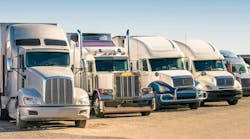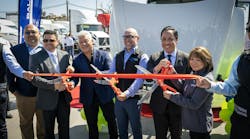Jeff Shefchik believes that natural gas will eventually become the fuel of choice for the transportation industry. Because of that, Shefchik, president of Paper Transport Inc., is very interested in utilizing the fuel in the company's 300 or so trucks. Based in Green Bay, WI, Paper Transport is running seven Freightliner M2 natural gas trucks with Cummins ISL G engines already and now has become involved in the testing of a dual-fuel natural gas vehicle.
“What we've been doing is testing every technology out there with natural gas,” Shefchik says, “because we believe it's the fuel of the future for our industry.”
Paper Transport, which is a regional hauler running dedicated and regional runs, is currently testing a 2009 Freightliner Cascadia with a 14.8L Detroit Diesel DD15 Series engine running on a combination of natural gas and diesel fuel. The dual-fuel system is supplied by American Power Group (APG).
“It was probably the summer of 2009 when we started getting into natural gas trucks,” Shefchik says. “In December, we saw an article on American Power Group and their dual-fuel truck. The advantage of the dual fuel is you maintain the efficiency of the diesel engine and if you run out of natural gas, you're not stranded.”
The test truck uses the APG V-3000 dual-fuel system. According to APG, the system can be run on compressed natural gas (CNG), liquefied natural gas, well-head gas, or biomethane, resulting in a net fuel cost saving of 25-35% per vehicle. The system is noninvasive to the existing diesel engine and has few moving parts, Shefchik says.
MARKET POTENTIAL
“On April 8, 2011, the EPA formally amended the alternative fuel aftermarket conversion regulations for light-, medium-, and heavy-duty vehicles, which opens the market for properly engineered systems to literally millions of diesel trucks on the road today,” says Lyle Jensen, president & CEO of GreenMan Technologies, an APG subsidiary.
Paper Transport's test truck is running on CNG, stored in a special tank on the passenger side of the vehicle. The tank replaces the standard diesel tank. According to Shefchik, an electronic control module with the system monitors the vehicle and injects increasing amounts of CNG into the fuel system based on the speed of the vehicle. At idle, the truck runs on 100% diesel, but as speed increases, more and more CNG is injected until the vehicle reaches cruising speed. At that speed, the vehicle runs on a 50-50 mix.
“There aren't really any moving parts that can break down,” Shefchik says. “If there are any fault codes, the [natural gas] system would shut itself off and switch to the diesel engine until the fault code is fixed.”
Paper Transport is providing data and feedback from the truck to APG for analysis.
According to APG, the dual-fuel system does not impact diesel engine power or pulling torque and assists in extending the engine's oil life since natural gas is a cleaner burning fuel compared to diesel. While full natural-gas trucks have range limitations, the dual-fuel vehicle does not. If it runs out of natural gas, it will simply run on diesel.
“We're trying to test the validity of the product,” Shefchik says. “We believe in the next several years, all of our trucks will run on natural gas, either dedicated or dual fuel.”
The dual-fuel truck, which is running between 2,000 and 2,300 mi. per week, is just one part of Paper Transport's fuel-efficiency equation. In addition to primarily spec'ing the aerodynamic Cascadia, the company has a max speed limit of 63 mph, uses low-rolling resistance tires, and focuses heavily on driver training and monitoring.
Shefchik says the company tracks and posts idle time and mpg, rewarding top-performing drivers with bonuses.


